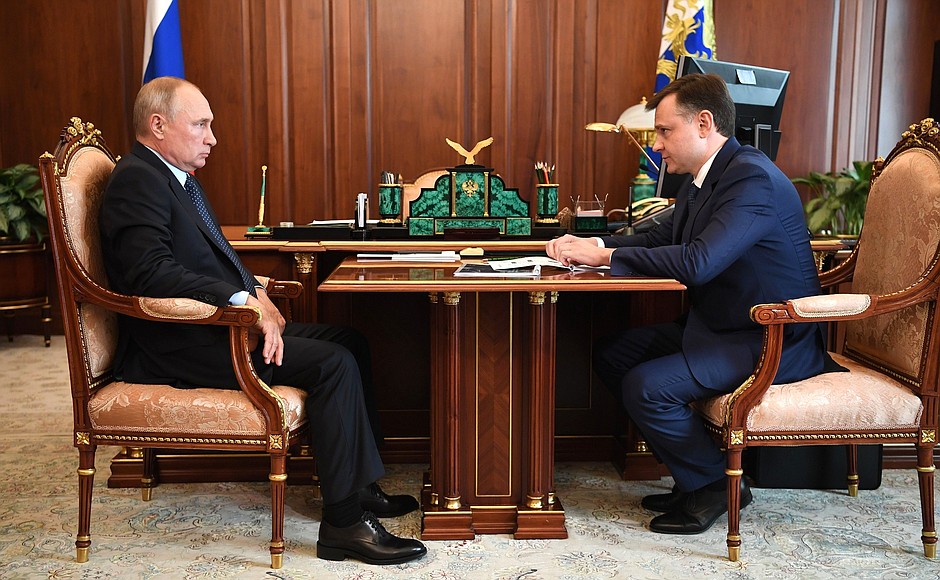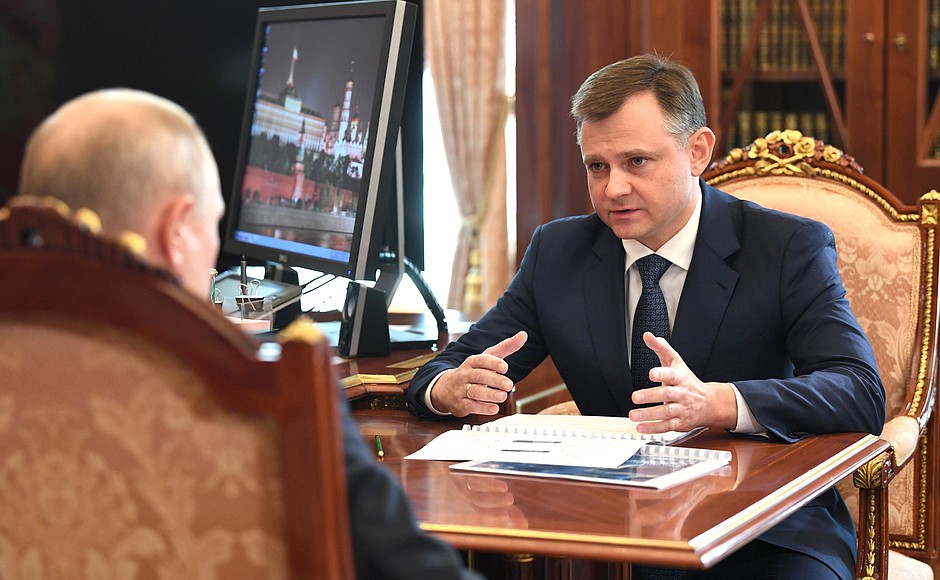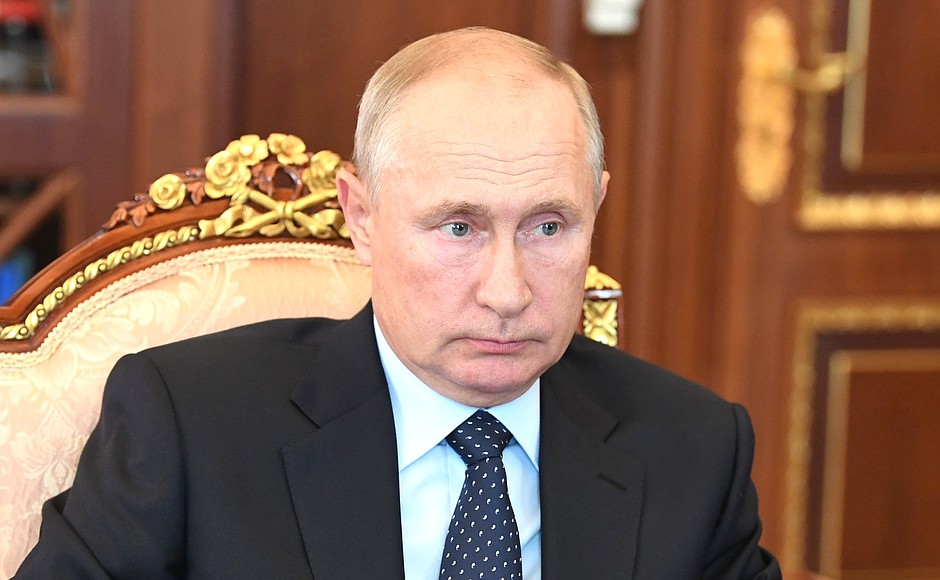
President of Russia Vladimir Putin: Good afternoon.
Mr Slyusar, we will, of course, speak about the company’s development in general. There is a plan for financial recovery, development of the company until 2035, right? Please, tell me how this plan is being implemented and how the company’s financial recovery is proceeding.
The United Aircraft Corporation includes, if I am not mistaken, six of our large, world-famous companies. I would like to hear from you how the work is being organised in each of these directions and, of course, on new products, new aircraft.
But I would ask you to start with the plane we plan to use to improve transport accessibility in the Russian Federation regions – the Il-114–300. Please.
General Director of the United Aircraft Corporation Yury Slyusar: Mr President, first of all, I would like to thank you and report on the implementation of the decisions you made at the meeting held on May 13. As you remember, they were anti-crisis and concerned both civilian and military issues.
Together with our colleagues from the Defence Ministry and the Ministry of Industry and Trade – many thanks to them – we quickly developed and approved a solution, which actually doubled the workload of our military enterprises and which provides for the advance delivery of aviation equipment.
We have a workload as finalists for enterprises, the entire cooperation has workload production, and accordingly, the Aerospace Forces receive a modern mass-production system.
I would especially like to note that our largest plant in Komsomolsk-on-Amur actually doubled its workload in the current period thanks to this decision, and now, through 2028, we have in effect a full workload at this plant.
If we also take into account the planned contacts as part of military technical cooperation: we believe the Su-35, as I have reported to you repeatedly, is the best aircraft. To be quite frank, its promotion to foreign market does involve a lot of difficulties, and our competitors often use what we see as unfair competition. I mean, apart from fair and competitive action, they also use direct pressure – political, sanctional and personalised pressure. But we are sure that our equipment is the best, and those countries that are buying this equipment now can certainly appreciate it. We believe that our aviation technology is the most competitive at present. And the example of the Komsomolsk factory shows how, in fact, in this situation, this decision [purchase of aviation equipment in advance] has influenced the workload of our military plants.
As for the civilian part, you have given instructions to use state guarantees for the supply of 59 Sukhoi Superjet aircraft. We have airlines as customers for the aircraft, including Aeroflot – the flagship carrier is buying 22 aircraft.
We are very grateful to our colleagues from Aeroflot, because we do really understand that the air transportation market has almost halved. Nevertheless, they are ordering new aircraft. They are ready to buy eight aircraft this year, and 14 next year.

We even believe the 100-seater Sukhoi Superjet is the best option in this pandemic period. Destinations earlier served by 200-seater planes now use 100-seater planes. And it fits well into the concept of fulfilling your instruction to develop regional traffic bypassing Moscow, especially in the regions of the Far East and Siberia.
About our new strategy, I know that Mr Savelyev [the head of Aeroflot] has reported to you about the company’s new strategy, which includes a spin-off of the Rossiya airline as a base company that uses domestic aircraft. We believe the Sukhoi Superjet is ideal for the development of this airline's business.
As for aviation events, I would like to report to you on them. Over the past year, we have put three aircraft into operation. This is primarily the Il-112V aircraft in Voronezh, our light military transport aircraft, which is replacing the entire Antonov family of An-26 aircraft. Hundreds of these planes are now in operation; the planes were produced in the Soviet Union. Of course, the plane is in great demand.
For Voronezh – where we produce the Ilyushin Il-96 planes and earlier produced the Antonov An-148 planes, unfortunately, this programme was discontinued in 2018 – for them, this also means loading enterprises, because hundreds of such planes are needed in the coming years. Such a plane saw the sky last year. Together with the Defence Ministry, we have launched, we have already developed and are implementing a decision to launch a pilot batch, we are producing two more aircraft and will involve them in testing.
The second aircraft that was produced was the Tupolev Tu-22M3M. This is a heavily upgraded aircraft based on the Tupolev Tu-22M3. This is a start, by and large, this is aerodynamic styling, a completely new plane, with a new set of onboard equipment, avionics, an onboard complex, and flying boom refuelling. That is, it is a fundamentally new aircraft with enhanced combat capabilities for our latest weapons.
And the third plane that was produced last year, we showed you this plane – the unmanned Okhotnik (Hunter), our attack heavy drone with unprecedented capabilities, having the largest combat flight range, the widest range of weapons, the broadest range of equipment. Planes of this class are only designed and manufactured by two countries, the USA and China.
The Defence Ministry instructed us to speed up the design and test works, to move it “to the left” as much as possible so that deliveries begin as early as 2024. Therefore, we are now actively working on this issue with our colleagues.
This year we have three product launches. The closest is the IL-114 you mentioned. The prototype has already been assembled and is undergoing ground trials, preparing for its maiden flight. I think that in September, we will fly it in Zhukovsky in the Moscow Region, according to our plans.
Alongside this, the bench trials and ground trials are also underway; an after-sales service system is being created, as well as a training facility for pilots and engineers.
This model will be in great demand because it is badly needed, specifically in remote regions. It is going to replace Antonov An-24s and foreign, Canadian, Q400s. Those carry 68 passengers. A turboprop aircraft with a speed of 500 kilometres.

Vladimir Putin: 500 kilometres per hour?
Yury Slyusar: 500 kilometres per hour. It is an all-weather and easy to use model, can land on any terrain and does not require a large set of ground equipment to maintain it – it has a built-in maintenance system.
In addition to the civilian version, we plan to make another version for our special customers. This option will also enjoy high demand, because it replaces the old Ilyushin aircraft.
Those will be manufactured in Lukhovitsy where we are now making the MiG-35s, the entire MiG family, using a parallel production line in the same workshop, the most cutting-edge final assembly workshop. In fact, we plan to produce up to 12 aircraft a year there.
The second premiere is also expected in the near future. I hope that the long-awaited upgraded Tu-95 will take off in Taganrog by the end of August. The new version is not just based on the old airframe. We have also altered the airframe by reinforcing the wings and changing a few more airframe units.
It has a new set of weapons, new on-board electronic equipment, new modified engines, new propellers, so in fact, its combat capabilities have doubled after this modernisation. After the flight trials, other tests will continue, and we are planning a major upgrade of the entire fleet of long-range strategic missile carriers that will continue along this path.
Another major launch we also plan this year is the flight of the MC-21 with Russian-made PD-14 engine. We must complete the project by the end of this year. The new engines have already been installed on the aircraft in Irkutsk, and now they are undergoing the necessary trials, so in fact, the new MC-21 aircraft with the newest certified PD-14 engine will fly soon.
Vladimir Putin: Good.
<…>